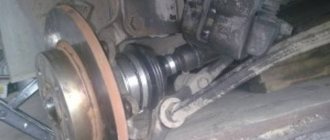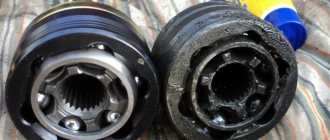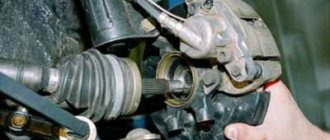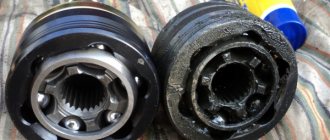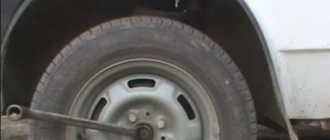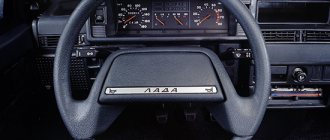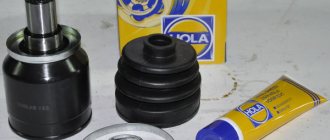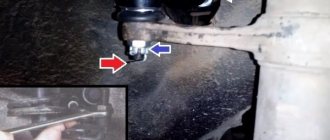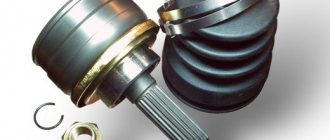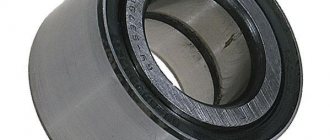If crunching and knocking noises appear in the front part of the car, the CV joint on the VAZ 21099 needs to be replaced. They are especially pronounced when driving over uneven places and on turns. Many car enthusiasts immediately head towards a car service center, but you can replace the CV joint on a VAZ 21099 with your own hands, without resorting to the help of specialists. In this situation, it is better not to leave the solution to the problem for later, so as not to lead to a disastrous result.
If you notice noise in the front of the car, you should immediately start checking the CV joint boots. Perhaps this is precisely the problem - there may be cracks, traces of grease, or even become unusable, namely, torn. To check, turn the steering wheel all the way to the side at your discretion and look at the area under the wheel.
If you find damaged areas on the dust cover, you must immediately replace it with a new one, otherwise it will become clogged with water, stones, dust and others, which will lead to its inapplicability. And when driving around corners, a knocking noise may occur, which indicates faulty joints. To check them, it is worth rocking the drive shaft - this is to check for the presence of play.
What role do CV joints play and how are they designed?
Torque from the gearbox to the front wheel hubs is transmitted by two drive shafts. Constant velocity joints (CV joints), popularly called grenades, are installed at the ends of the shafts, as they look like a grenade with a handle.
The hinges connecting the shaft and gearbox are called internal, those that connect the shaft and hub are called external.
Their purpose is the same as that of the crosspieces in the cardan transmission of rear-wheel drive cars, but they carry a load several times greater, because the force is transmitted without a gearbox.
CV joints must ensure continuous transmission of torque from the power unit.
Smooth operation of the movable joint is impossible when:
- wear of the guide tracks of the body and inner race;
- deformation of balls;
- ingress of dirt;
- lack of lubrication.
When the balls jam for a short time and then “slip” along the track, the hinge produces a characteristic crunch. Over time, the separator holding the balls will collapse from impact loads and torque transmission will become impossible. That is, the car will not move.
The inner CV joint has a lower degree of rotation, but a greater ability to move the inner race relative to the body - it is due to this that the lateral vibrations of the engine and gearbox are compensated.
Both hinges have spline connections to the shaft and are secured to it with retaining rings. On the VAZ 21099, the outer CV joint with the hub, and the inner one with the gearbox, are also connected by splines.
The units are protected by rubber covers to prevent the ingress of water, dust and dirt.
Replacement methods
There are two methods for replacing the external CV joint on an Audi A6 C5 with your own hands - with disconnecting the suspension arms from the steering knuckle and without this operation.
With detachable levers
We will consider replacing hinges with preliminary disconnection of the levers using the example of the left outer CV joint.
The operation is performed like this:
- We park the car on a level surface, engage the handbrake and engage first gear at the gearbox. Additionally, you can put wheel chocks under the rear wheels;
- We remove the cap and using a 27 socket with a wrench, we tear off the bolt securing the drive to the hub, and also loosen the wheel fasteners;
- We tear off 5 disk bolts;
- Use a jack to lift the front of the car on the left side and remove the wheel;
- Completely unscrew the drive mounting bolt;
- Turn the steering wheel to the left all the way;
- We clean the steering knuckle mounting bolt from the upper suspension arms, unscrew it (you will need two 16mm wrenches) and knock it out;
- Carefully remove the tips of the levers from the fist, causing the latter to move to the side;
- Having “bent” the hinge all the way, we remove it from the hub. Do not forget to turn the steering wheel to the right (when replacing the left CV joint);
- We remove (cut) the clamps. We pull the boot together or simply cut it off;
- We align the CV joint end cap relative to the shaft (so that they are located on the same axis);
- We pull the joint off the shaft. To do this, install the mounting bolt back and tighten it with a wrench until it stops. Then we turn on the gear to lock the CV joint and further screw in the bolt until the unit “comes off” from the retaining ring located on the shaft;
- Remove the retaining ring, bushing and thrust ring;
- We thoroughly wash the shaft and wipe it with a rag;
- We put a clamp on the drive shaft;
- We do the same with the new boot;
- Next, we put the first washer on the shaft (with its bottom towards the engine);
- Install the second plastic washer;
- We install the retaining ring last;
- We put lubricant in the hinge. There are new CV joints for the Audi A6 C5 already filled with grease, which is very convenient;
- We also put lubricant in the boot;
- We put the new CV joint on the shaft splines, and then seat it all the way, using a hammer and a wooden adapter (we seat it carefully so that dust does not get into the lubricant). Next, take the old bolt, screw it into the hub and use a hammer to push the CV joint onto the shaft. You can check whether the hinge is completely seated by looking at the plastic bushing - it should be almost completely “hidden” inside the unit;
- We put the boot on the outer ring. To do this, you will have to use a screwdriver and remove the car from the gear. We fix the rubber element with clamps, clamping them with pliers;
- Then we do everything in reverse order. We install the drive in the hub and attach the mounting bolt;
- We reconnect the steering knuckle to the suspension arms and secure everything with fasteners;
- We put the wheel in place, lower the car from the jack;
- Tighten the drive and wheel fasteners.
POPULAR WITH READERS: Choosing the type of shock absorbers for a car
At this point, the replacement of the external CV joint on the Audi A6 C5 is considered complete.
In some cases, it is not always possible to unscrew the fastening of the knuckle to the upper arms. If these bolts have not been loosened for a long time, then over time they “stick” and are difficult to unscrew. An alternative option in this situation is to unscrew the lower arms from the knuckle.
In fact, to replace the outer CV joint on an Audi A6 C5, it makes no difference which levers to disconnect the steering knuckle from - upper or lower, in both cases the hub will move to the side, which will allow you to remove the drive limit switch.
Do-it-yourself CV joint removal
In order to replace the internal grenade, you will definitely need to “pull out” the drive from the gearbox. This is achieved either by sharply pressing the “mount” inserted between the gearbox housing and the hinge body, or by striking (through a drift of suitable length) the hinge directed along the drive axis. Before this, it is advisable to drain about a liter of oil from the gearbox, restoring its level after repair.
The outer CV joint can be replaced directly on the car, but it is still more convenient to work by holding the drive shaft assembly with grenades removed from the car in a vice. So, rolling up our sleeves, let's proceed to the following steps:
- We “tear off” the hub nut and wheel bolts.
- We hang the wheel and remove it.
- Disconnect the steering end and ball joint.
- We move the strut away, pushing the outer CV joint out of the hub.
- We pull the drive out of the box and install it in a vice.
- Unfasten the clamps on the rubber boot and move it.
- We place a copper drift on the inner ring (clip) of the joint and with a sharp blow knock it off the shaft.
If you need to replace a torn boot, and the hinge itself is not yet “crunchy,” then before reassembling, thoroughly rinse the grenade with gasoline and blow it with compressed air.
Causes and breakdowns
In reality, the resource of the CV joint turns out to be significantly less, which is caused by operating conditions, poor quality of roads, driving habits and other factors.
The CV joint is popularly called a “grenade,” which is due to the external similarity of the element to this explosive device.
Here's what you should know about grenade malfunctions:
- Practice shows that the most common cause of CV joint failure is dirt, dust, and sand that enter the mechanism through a damaged boot;
- Sometimes the problem of a non-functioning grenade can be solved by replacing the boot. This is possible if the CV joint itself has not yet worn out due to exposure to contamination;
- If the damaged boot is not detected in time, the grenade will be completely worn out within literally 200 kilometers;
- If the CV joint fails, a strong crunching sound appears when cornering and accelerating. Such a symptom indicates the need to urgently replace the CV joint;
- The cost of new grenades is quite affordable; they are available at any auto parts store. But you should purchase those that meet the technical requirements of the VAZ 2109;
- If you have at least a little experience in repairing cars yourself, it is quite possible to replace a grenade with your own hands.
Determining the malfunction
First of all, when driving, there may be extraneous noise from the front. First you need to make sure that the CV joint boots are not torn and there are no cracks or oily marks on the surface. To check, just turn the steering wheel all the way and carry out a visual inspection behind the wheel.
Found any damage? Change the boot immediately so that stones, small particles, and water do not subsequently get into the CV joint mechanism. Otherwise, the hinge will quickly become unusable.
It is quite easy to determine the need to replace the hinge itself - during turning maneuvers the driver notices characteristic knocking noises. The presence of play during swinging of the drive shaft will help confirm this fact.
Replacing the outer CV joint of a VAZ 2109 (2108, 21099)
You can replace the outer CV joint (angular velocity joint, “grenade”) on a VAZ 2109 (2108, 21099) without removing the wheel drive.
Necessary tools, accessories and spare parts
Soft metal drift
Key "30" (knob with head)
Key "17" (head or socket)
Pliers (preferably extendable)
Slotted screwdriver or circlip remover
New outer CV joint (they are the same for both wheel drives of the car)
New CV retaining ring
CV joint lubricant (CV joint-4 or equivalent) 40 g
New hub nut
If necessary, CV joint boot and clamps for it
Preparatory work
Place the car on a level surface and securely fix it (handbrake, wheel chocks)
Malfunctions and their symptoms
The hinge components are made of high-quality materials, and the working surfaces have high-quality processing. Therefore, VAZ-2108 CV joints can work for a significant period without any intervention or maintenance of the unit itself.
But there is one caveat - the reliability of the unit is maintained only if there is no contamination. The ingress of sand and dust, which are abrasives, intensively wear out the working surfaces, which leads to the destruction of the hinge.
The assembly is protected from contamination by anthers - special rubber elements, fixed on the shaft with a clamp on one side, and on the outer race on the other.
But the resource of the anther is limited. Due to constant contact with the external environment, the rubber “ages”, which leads to the formation of cracks through which sand and dirt penetrate into the unit.
Diagnostics of the drive comes down to inspecting the anthers. If even minor cracks are detected, an immediate replacement of the CV joint boot 2108 is required. Additionally, the element is washed and fresh lubricant is added.
If you do not change the CV joint boot on a VAZ-2108 in a timely manner, the sand will wear out the working surfaces so much that the joint will simply crumble. It is noteworthy that even with slight wear of the surfaces, it will no longer be possible to correct the damage, since the unit cannot be repaired.
A sign that a VAZ-2108 CV joint needs to be replaced is the appearance of a pronounced crunch and clicking sound when turning the steering wheel. With slight wear, third-party sounds appear only at the extreme positions of the steering wheel, but as wear progresses, a crunching sound appears at lower turning angles.
At the initial stages, you can still try to extend the service life by washing, adding lubricant and replacing the boot. But we note that if a crunch appears, it means that the working surfaces have already begun to wear out, and these procedures will only delay the replacement of the unit, but in the end it will have to be done.
Removing the hinge
It is advisable to treat all unscrewed bolts and nuts with WD-40 a day before replacing the outer hinge, thus significantly reducing the effort spent on unscrewing these elements. If this is not possible, we process the bolts and nut immediately before starting repair work.
Rice. 3 - Place of treatment with WD-40
Rice. 4 - Areas of treatment with WD-40
Set the car's steering wheel straight, engage first gear and apply the parking brake. For those for whom it does not work, I suggest reading this article. Under the front wheel, in which the outer joint is changing, we install two bricks, as shown in the figure below, to prevent rotation and scrolling. Use an impact screwdriver to loosen the nut. Using a “30” socket with a long handle, unscrew the hub nut, turning the wrench counterclockwise, regardless of which side the CV joint is being replaced from (!).
Rice. 5 — Unscrewing the hub nut
Having removed the nut, unscrew it and remove the washer. Then loosen the wheel bolts and jack up the front wheel. We place stump or bricks under the front side member so that when the jack is removed, the front wheel still remains raised a few centimeters above the ground. Now you need to hang the other front wheel in the same way. This is necessary in order to break the transmitted force from one suspension to another through the transverse stability beam. Then unscrew the wheel bolts and remove the wheel from the side we need. The result should be the same as in the figure below.
Rice. 6 — Hanging the front wheels using bricks
Now, using the “16” head, you need to unscrew the two bolts securing the ball joint to the steering knuckle. It’s not very convenient to do this without a hole, but it’s quite possible.
Rice. 7 — Unscrewing the ball joint bolts from the steering knuckle (body elements have been removed for clarity)
Next, move the strut to the side so that the outer hinge comes out of the hub.
Rice. 8 — Output of the outer hinge from the hub
We loosen the clamps of the CV boot and remove them, and cut the boot itself so that it does not interfere. To remove the outer joint from the shaft, you need to use a flat (slotted) impact screwdriver to crawl between the retaining ring and the joint separator, and use a lever to pull it off the drive shaft, while holding the shaft with the other hand, as shown in the figure below.
Attention! Never pull the drive shaft towards you, as it may come out of the inner joint!
Rice. 9 — Removing the CV joint using a screwdriver
Rice. 10 — Installing a screwdriver between the retaining ring and the hinge separator
If you did it as shown in the figure, the hinge should be easily removed from the shaft. Replacing the locking half-ring is completely optional if its external integrity is intact. Then we take out a set of new outer CV joint and get ready for installation.
Installation
We take out the boot and put it on the drive shaft, after which we fix its inner part with a small clamp. The fixing process is very simple - after the hole gets into the recess, we tighten the clamp using wire cutters. Inside the boot we place at least 40 cm3 (the equivalent of two matchboxes) of CV joint grease-4, which comes complete with the new hinge.
Rice. 11 — Installing the boot and clamp tie
Attention! Never reuse parts such as clamps and hub nuts, as these parts are disposable!
After this, we put on the hinge and, with light blows of a hammer, hammer it in until it stops. We put on the boot and secure it with a large clamp, similar to the small one. Now you need to get the hinge splines into the spline hole of the hub, and then put on the washer and hub nut. Next, we bring the strut into position above the ball joint and tighten the pre-oiled bolts.
Rice. 12 — Installing a new hinge
Rice. 13 — Clamp tie
Note:
It is recommended to lubricate all bolts discussed in this article. This will slow down the oxidation of the bolts, and in the future will allow you to unscrew them with less effort.
We put on the wheel and first tighten the oiled wheel bolts. Next, you need to lower the car onto the wheels, and then place bricks under the “operated” wheel. Tighten the wheel bolts with normal force and the wheel nut with a torque of 220 Nm. If there is no special wrench, tighten the nut with maximum force, after which you need to lock it using an impact screwdriver and a hammer.
After the car has driven 500-1000 km, re-check the tightness of the ball joint bolts and, if necessary, tighten them.
Checking the condition of the CV joint
To carry out diagnostics it is necessary to use several methods. After all, you need to determine whether the VAZ-2109 CV joint needs to be replaced. The very first is the appearance of a crunch when cornering. As a rule, this is a sign that the outer hinge is very worn and requires replacement. In addition, a similar crunching noise may occur when reversing. This is not fatal, but it is also not very pleasant, since you have to forget about a comfortable ride.
The main thing when diagnosing is not to confuse the symptoms with those that occur when certain suspension elements break down. For example, when moving in a straight line, only heavily worn joints will crunch. The most common cause of such sounds is the ball joint. A more detailed picture can be obtained if the car is placed on a lift and the entire suspension is suspended. In this position, you can determine what kind of play the hinge has, and whether there is a knock in the ball joint. In addition, this position is most convenient when replacing the outer CV joint of a VAZ-2109.
You can talk endlessly about how to change joints correctly, what lubricant to use, which manufacturer you should trust. In fact, the most suitable components are those whose manufacturers supply them to the AvtoVAZ plant. When replacing the external CV joint of a VAZ-2109, preference should be given to the manufacturer who supplies them to the plant. As practice shows, the service life of these elements turns out to be higher than that of foreign analogues. No matter how much they scold our auto industry, the reliability of domestic units is an order of magnitude higher than the vaunted German or Italian ones.
How to look younger: the best haircuts for those over 30, 40, 50, 60 Girls in their 20s don’t worry about the shape and length of their hair. It seems that youth is created for experiments with appearance and daring curls. However, already last.
Our ancestors slept differently than we do. What are we doing wrong? It’s hard to believe, but scientists and many historians are inclined to believe that modern man sleeps completely differently than his ancient ancestors. Initially.
10 charming celebrity children who look completely different today Time flies, and one day little celebrities become adults who are no longer recognizable. Pretty boys and girls turn into...
11 Weird Signs That You're Good in Bed Do you also want to believe that you please your romantic partner in bed? At least you don't want to blush and apologize.
Never do this in church! If you are not sure whether you are behaving correctly in church or not, then you are probably not acting as you should. Here's a list of terrible ones.
9 Famous Women Who Have Fallen in Love with Women Showing interest in people other than the opposite sex is not unusual. You are unlikely to be able to surprise or shock anyone if you admit it.
Tool
Tools needed to replace the outer CV joint:
— a “30” head with a long handle (for unscrewing the hub nut); — head on “19” (for unscrewing wheel bolts); — head at “16”; - jack; — bricks or hemp (for hanging the front of the car); — WD-40; - flat (slotted) impact screwdriver; - wire cutters; - hammer; — a new set of outer CV joints.
Rice. 2 - Necessary tool
Note:
Contrary to popular belief, to replace the outer CV joint it is not necessary to drain the oil from the gearbox.

